TIPWelcome to my CS205 lecture notes! Because the lecture is not in English, I will try my best to translate it.
And at the same time, the
PPT,lab-filealso use the English,I will write the English notes but not all.
NOTEIf you have a passion to konw more about the course, you can click the link below to learn more about the course. Read the repo.
Waiting for api.github.com...
WARNING由于本文篇幅过长,个人会添加适当的中文注解在里面。
Topic Overview
- Class in C++:
- Class constructor and destructor
- Static member variables and static member functions
- Const member variables and const member functions
thispointer- Class, object, member variable, member function, static variable & memory Management
- Class in Python vs Class in C++:
- constructor and destructor
- static members
- const members
selfpointer
- Practice Exercises
Foreword
Welcome to the Lab 9 study notes! This lab primarily introduces the basic concepts and usage of classes in C++, including constructors, destructors, static members, const members, and the this pointer. We will also compare the similarities and differences between classes in C++ and Python.
C++ Class Basics
1.1 Static Member Variables
Static member variables are shared among all objects of a class. This means that no matter how many objects of the class are created, there is only one copy of the static member variable in memory.
Characteristics:
- Shared by all objects of the class.
- Only one copy exists in memory.
- Must be explicitly defined and initialized outside the class definition (unless it is
static constof an integral or enumeration type, which can be initialized within the class). - Its name needs to be qualified with the class scope resolution operator
::.
Definition and Initialization:
// Declare in class definition class StaticTest { private: static int m_value; // Declare static member variable public: // ... }; // Define and initialize static member variable outside class definition int StaticTest::m_value = 12;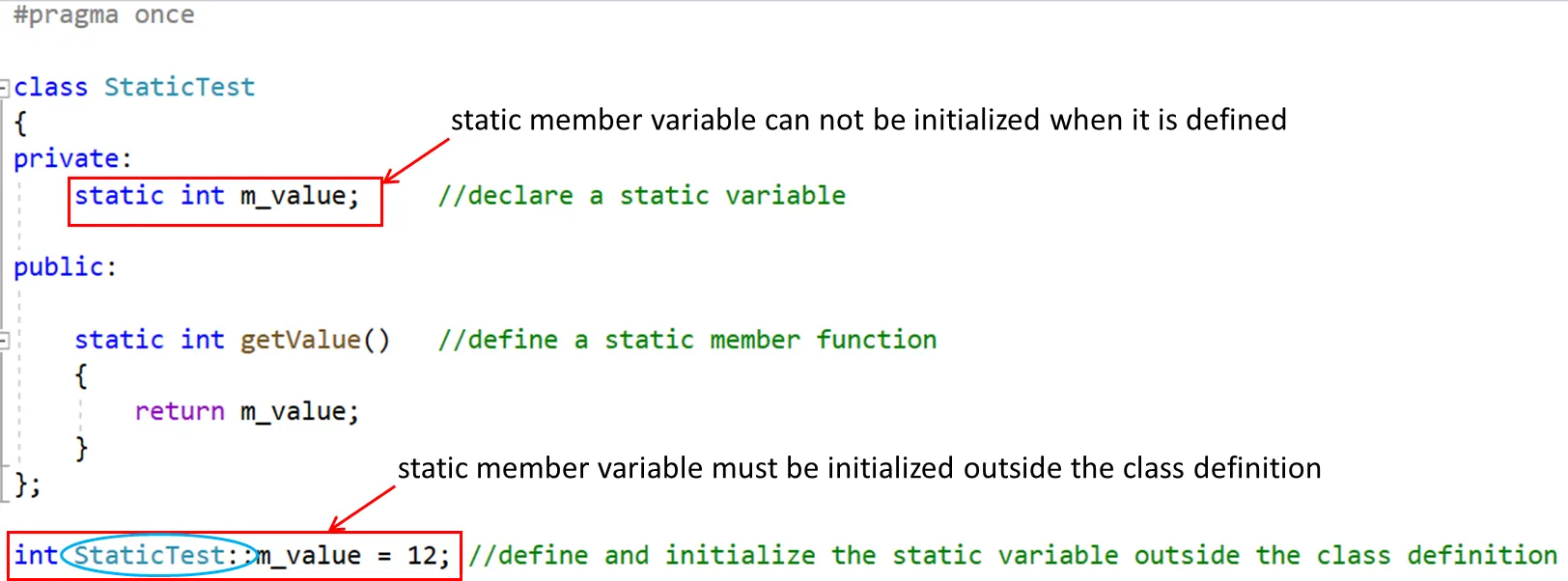
1.2 Static Member Functions
Static member functions can be called independently of any object of the class. A member function can only be declared as static if it does not access any non-static class members (i.e., it does not depend on members of a specific object).
Characteristics:
- Can be called directly using the class name, or through an object.
- Cannot access non-static member variables or non-static member functions (because they do not have a
thispointer). - Can access static member variables and other static member functions.
- Declared using the
statickeyword.
Definition and Invocation:
class StaticTest { private: static int m_value; public: static int getValue() { // Define static member function return m_value; } }; int StaticTest::m_value = 12; // Invocation methods // StaticTest t; // int val1 = t.getValue(); // Call via object // int val2 = StaticTest::getValue(); // Call via class name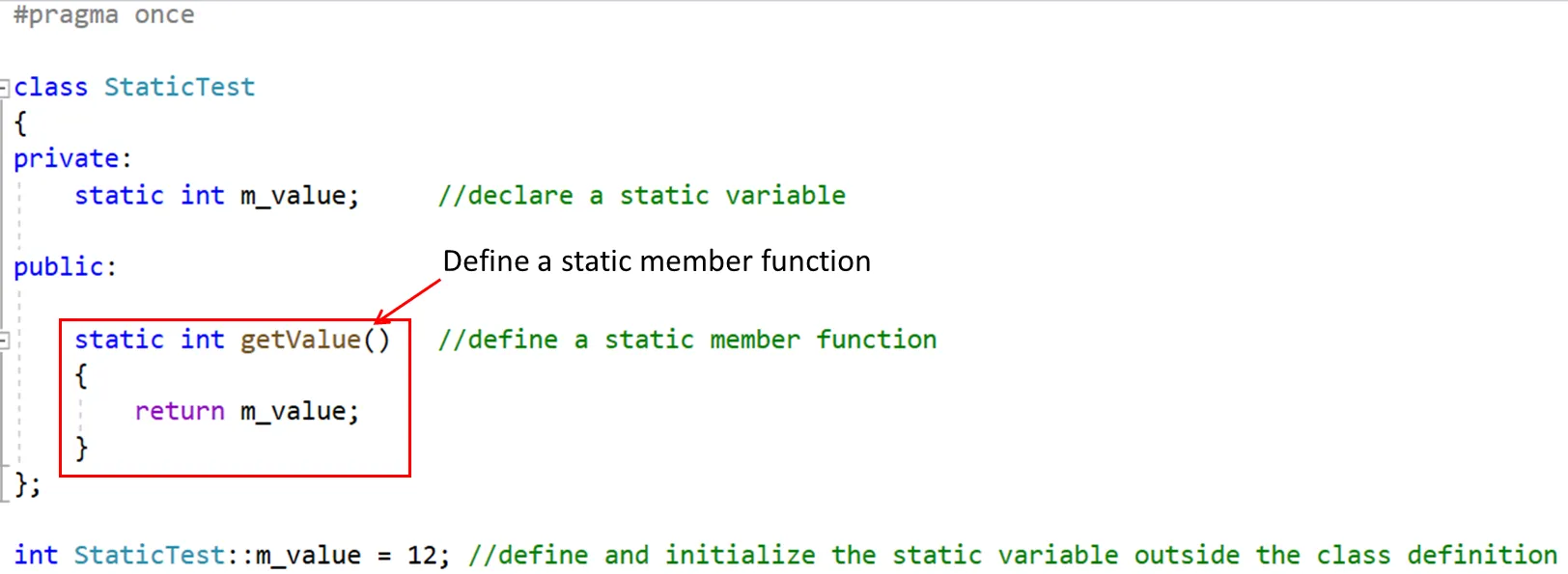

TIP
You can use object or class to access the static members.
1.3 Const Member Variables
The const keyword specifies that a variable’s value is constant and tells the compiler to prevent the programmer from modifying it. If some member variables do not need to be modified during the object’s lifetime, they can be defined as const.
Characteristics:
- Value cannot be modified after initialization.
- Must be initialized in the constructor’s member initializer list.
Definition and Initialization:
class MyClass { private: const int x; // const member variable public: MyClass(int a) : x(a) { // Initialize const member via initializer list // constructor body } void show_x() { std::cout << "Value of constant x: " << x; } };
Static Const Member Variable:
- If it’s an integral or enumeration type, it can be initialized directly within the class definition.
- Other types of
static constmember variables are usually initialized outside the class (but still declared inside).
class Person { private: static const int Len = 30; // In-class initialization for static const int char name[Len]; public: // ... }; //const int Person::Len;For non-integral types or those needing more complex initialization,define
static constoutside the class.const int Person::Len;If not initialized in-class, define outside.
Alternatively, an enumeration can be used to define an in-class constant:
class Person { private: enum { Len = 30 }; // Using enum to define a constant char name[Len]; public: // ... };
1.4 Const Member Functions
A const member function promises not to modify any data members of the object that calls it (unless a member is declared mutable). The const modifier follows the function’s parameter list.
Characteristics:
- The
constkeyword must be specified in both the function’s declaration and definition (if defined outside the class). - Cannot modify non-static data members of the object.
- Cannot call non-
constmember functions of the object. - Can be called by both
constand non-constobjects.
- The
Definition:
// complex.h class Complex { private: double real; double imag; public: // ... void Show() const; // Declare const member function }; // complex.cpp void Complex::Show() const { // Define const member function std::cout << real << " + " << imag << "i" << std::endl; }
1.5 this Pointer
Each class has only one copy of its member functions, but there can be many objects of that class. Each object can access its own address through a special pointer called this. The this pointer is passed by the compiler as an implicit argument to each of the object’s non-static member functions.
Characteristics:
- Inside a non-static member function, the
thispointer points to the object that invoked the member function. thisis a constant pointer; you CANNOT change the value of thethispointer itself, but you can modify the content of the object it points to (unless in aconstmember function).- Its type is
ClassName* const(for non-constmember functions) orconst ClassName* const(forconstmember functions). - Often used to return a reference or pointer to the object itself, or to distinguish between member variables and parameters with the same name within a member function.
- Inside a non-static member function, the
Usage Example:
class Box { double length, breadth, height; public: Box(double length, double breadth, double height) { this->length = length; // Use this to distinguish member variable and parameter this->breadth = breadth; this->height = height; } Box& copy(const Box& rhs) { this->length = rhs.length; this->breadth = rhs.breadth; this->height = rhs.height; return *this; // Return a reference to the calling object } };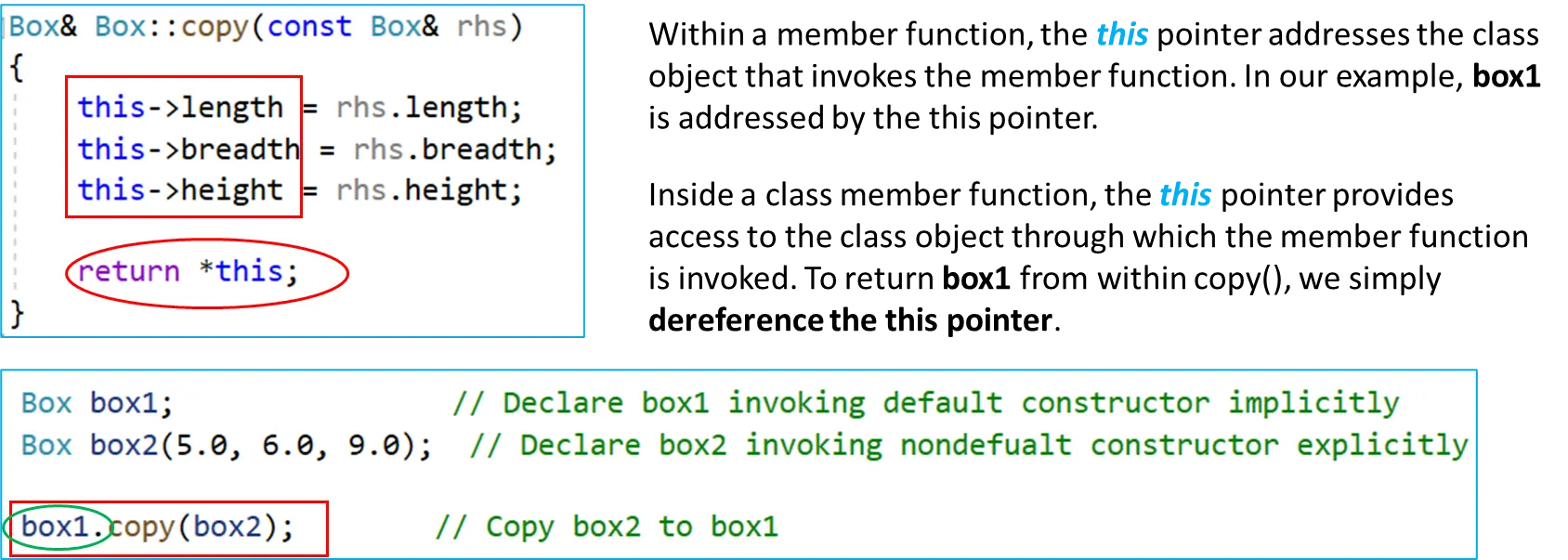
C++ Class Constructors
A class constructor is a special member function used to create and initialize objects of the class.
Characteristics:
- Has the exact same name as the class.
- Has
noreturn type (not evenvoid). - Is typically a
publicmember function of the class. - Is invoked automatically whenever an object of that class is created.
- Can be overloaded (i.e., a class can have multiple constructors with the same name, but their parameter lists must differ).
- Can have default arguments.
Default Constructor:
- A constructor that takes no arguments, or one where all arguments have default values.
- If the programmer provides no constructors for a class, the C++ compiler automatically generates a default constructor. This implicit default constructor does nothing (member variables are not initialized to specific values unless they have in-class initializers).
- If the programmer defines any constructor (with or without parameters), the compiler will no longer automatically generate a default constructor. If a way to create an object without arguments is still needed, a default constructor must be explicitly defined.
- A class can have only one default constructor.
Parameterized Constructor:
- Accepts parameters to initialize the object’s data members.
Member Initialization List:
- Follows the constructor’s parameter list, before the function body, starting with a colon
:, used to initialize member variables. - Mandatory for
constmembers, reference members, and member objects that do not have a default constructor. - Generally more efficient for other members than assignment within the constructor body.
- The order of initialization is determined by the order in which members are declared in the class, not by their order in the initializer list.
class Box { private: double length; double breadth; double height; public: // Default constructor (using initializer list) Box() : length(3.0), breadth(4.0), height(5.0) {} // Parameterized constructor (using initializer list and this pointer) Box(double len, double bre, double hei) : length(len), breadth(bre), height(hei) { // Alternatively, assign in the function body: this->length = len; etc. } };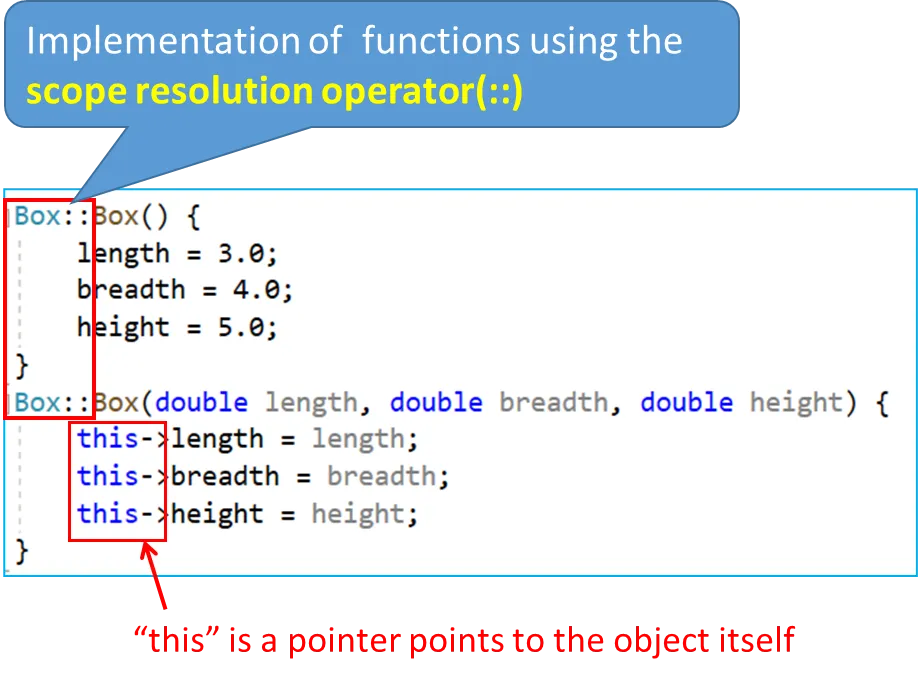
- Follows the constructor’s parameter list, before the function body, starting with a colon
Object Creation and Constructor Invocation:
Box first(5.0, 6.0, 9.0); // Calls parameterized constructor Box second; // Implicitly calls default constructor Box third = Box(); // Explicitly calls default constructor Box *pbox = new Box; // Dynamically creates object, implicitly calls default constructorBox fourth();declares a functionfourththat returns aBoxobject, not an object namedfourthcreated by the default constructor.To create an object using the default constructor, do not use parentheses.
TIP
参数化构造函数用于初始化对象时提供具体的参数。
默认构造函数用于在没有提供参数时初始化对象。
动态创建对象时,使用
new操作符,会隐式调用默认构造函数。显式调用默认构造函数可以通过
Box()的形式实现。
C++ Class Destructors
A class destructor is a special member function that is automatically called when an object of the class ceases to exist (e.g., when the object goes out of scope, or when a dynamically allocated object is deleted using delete). Destructors are typically used to perform cleanup tasks, such as releasing resources allocated by the object during its construction.
- Characteristics:
- The destructor’s name is the class name preceded by a tilde
~(e.g.,~Box). - Has no return type (not even
void). - Has no arguments.
- A class can have only one destructor.
- If the programmer does not provide a destructor, the compiler automatically generates a default destructor. This default destructor usually does nothing.
- Invoked when an object goes out of scope or
deleteis applied to a pointer to the object. - Destructors cannot be overloaded.
- The destructor’s name is the class name preceded by a tilde
- Purpose:
- Release dynamically allocated memory.
- Close files.
- Release other system resources.
class MyResource {
private:
int* data;
public:
MyResource(int size) {
data = new int[size];
// std::cout << "Resource allocated." << std::endl;
}
~MyResource() { // Destructor
delete[] data; // Release dynamically allocated memory
// std::cout << "Resource deallocated." << std::endl;
}
};C++ Class vs. Python Class Comparison
| Feature | C++ | Python |
|---|---|---|
| Access Control, Encapsulation | Controls member access through public, private, and protected. | No strict access control; privacy is simulated through naming conventions (e.g., _ or __). |
| Constructors, Destructor | Explicitly define constructor (same name as class) and destructor (~ClassName), controllable memory release. | Use __init__ constructor and __del__ destructor, but __del__ call is determined by garbage collection. |
| Method invocation, self/this | Implicit use of this pointer without explicit declaration. | Methods need to explicitly declare the self parameter to represent the object itself. |
| Static methods, class methods | Directly declare static member functions. | Use @staticmethod or @classmethod decorators. |
| Dynamics, Metaprogramming | Class structure is fixed at compile time and cannot be dynamically modified. | Classes and objects can be dynamically modified (e.g., adding methods at runtime). |
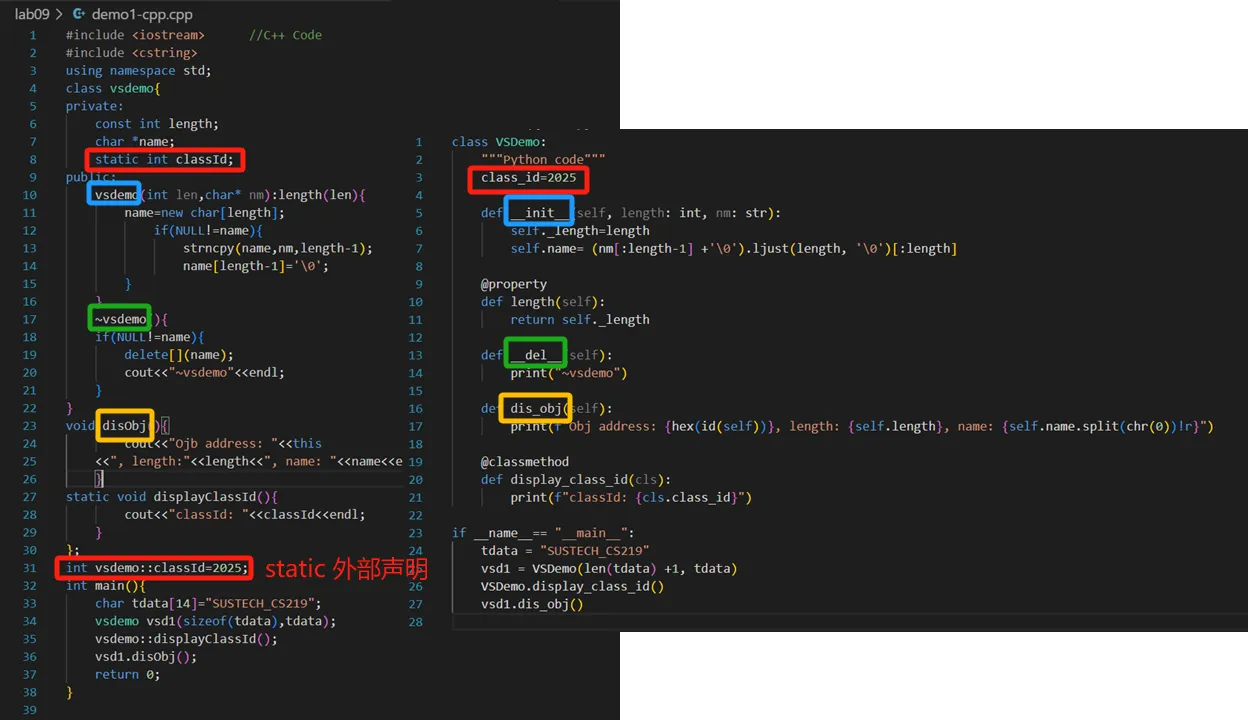
Python Code Example Explanation (Demo(1) and Demo(2) from slides):
- Class variables are similar to static member variables in C++.
__init__is the constructor, used to initialize member variables.- The
@propertydecorator can turn a method into a read-only attribute, partially similar to the effect ofconstmembers in C++. __del__is the destructor.- Regular methods are member functions; the first parameter is typically
self. - The
@classmethoddecorator creates methods similar to static methods in C++, where the first parameter is the class itself (usually namedcls).
Exercises
Exercise 1
- Can the program below be run successfully? Why?
- Modify the program to:
- 2-1) Fix the grammar errors.
- 2-2) Make the function invoked by an object display the value of the
thispointer and the member variableid. - 2-3) Make the function invoked by the class display the value of the static variable
num.
You need to explain the reason to a TA to pass the test.
#include<iostream>
using namespace std;
class Demo{
private:
int id;
void display(){
cout<<"this is: "<<this<<", id is:"<<this->id<<endl;
}
public :
Demo(int cid){
this->id=cid;
}
static int num;
void display()
{
cout<<"The value of the static num is: "<<num<<endl;
}
};
int main()
{
Demo obj;
Demo obj1(1);
obj.display();
obj1.display();
Demo::display();
return 0;
}
My implement:
#include<iostream>
using namespace std;
class Demo{
private:
int id;
public :
Demo() : id(0){
cout<<"Default constructor called"<<endl;
}
Demo(int cid){
this->id=cid;
cout<<"Parameterized constructor called"<<endl;
}
static int num;
static void display(){
cout<<"The value of the static num is: "<<num++<<endl;
// Note: A static function cannot access non-static members like 'this->id'
}
};
int Demo::num = 10; // Definition and initialization of static member variable
int main()
{
Demo obj;
Demo obj1(1);
obj.display();
obj1.display();
Demo::display();
return 0;
}

Exercise 2
What is the result of the program below? What happens if you uncomment the commented line in the main() function? Why? You need to explain the reason to a TA to pass the test.
#include <iostream>
using namespace std;
class ConstMember
{
private:
const int m_a;
public:
ConstMember(int a) : m_a(a) {}
void display() const
{
cout << "The value of the const member variable m_a is: " << m_a << endl;
}
};
int main()
{
ConstMember o1{666};
ConstMember o2{42};
o1.display();
o2.display();
// o1 = o2; // 如果o1=o2,表示值拷贝
return 0;
}
The results:

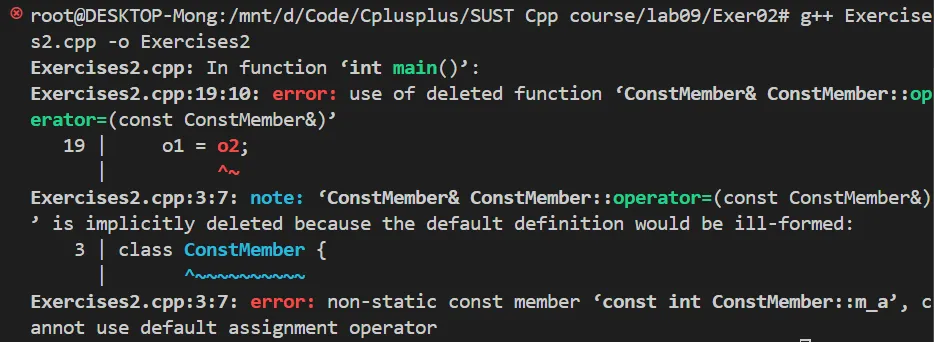
TIP编译器会尝试为
ConstMember类生成一个默认的赋值运算符函数 (operator=)。默认的赋值运算符会尝试逐成员赋值,即尝试执行
o1.m_a = o2.m_a;。但是,
m_a是一个const成员变量,它的值在初始化后不能被修改。因此,对其进行赋值操作是非法的。
Exercise 3
Define a class called Complex for performing arithmetic with complex numbers. Write a program to test your class. Complex numbers have the form realPart + imaginaryPart * i.
Use two member variables to represent the private data of the class. Provide a constructor that enables an object of this class to be initialized when it’s declared. The constructor should contain default values in case no initializers are provided. Provide public member functions that perform the following tasks:
- a)
add—Adds two Complex numbers: The real parts are added together and the imaginary parts are added together. - b)
subtract—Subtracts two Complex numbers: The real part of the right operand is subtracted from the real part of the left operand, and the imaginary part of the right operand is subtracted from the imaginary part of the left operand. - c)
display—Displays a Complex number in the form ofa + biora - bi, whereais the real part andbis the imaginary part.
TIPIf a member function does not modify the member variables, define it as a
constmember function.
Class Definition:
class Complex { private: double real; double imag; public: // Constructor (with default arguments) Complex(double re = 0.0, double im = 0.0); // Addition Complex add(const Complex& other) const; // Subtraction Complex subtract(const Complex& other) const; // Display (const member function) void display() const; };Constructor Implementation: Use a member initializer list.
addandsubtractImplementation: Create a newComplexobject as the result and return it. These functions should beconstas they don’t modify the calling object.displayImplementation: Pay attention to the output format, especially when the imaginary part is negative.
Click here to read these code.

CC BY NC SA (Content adapted from course materials)
